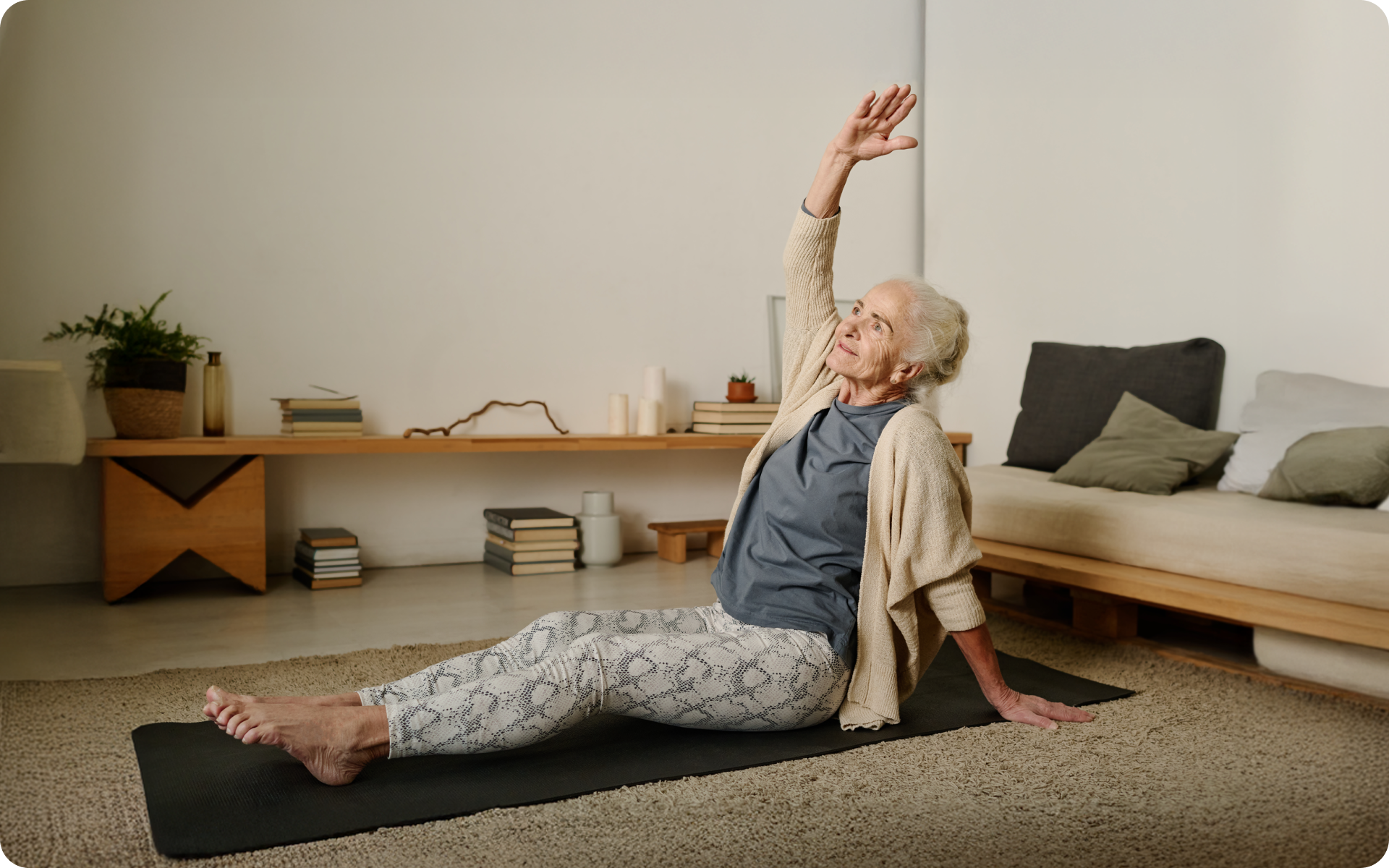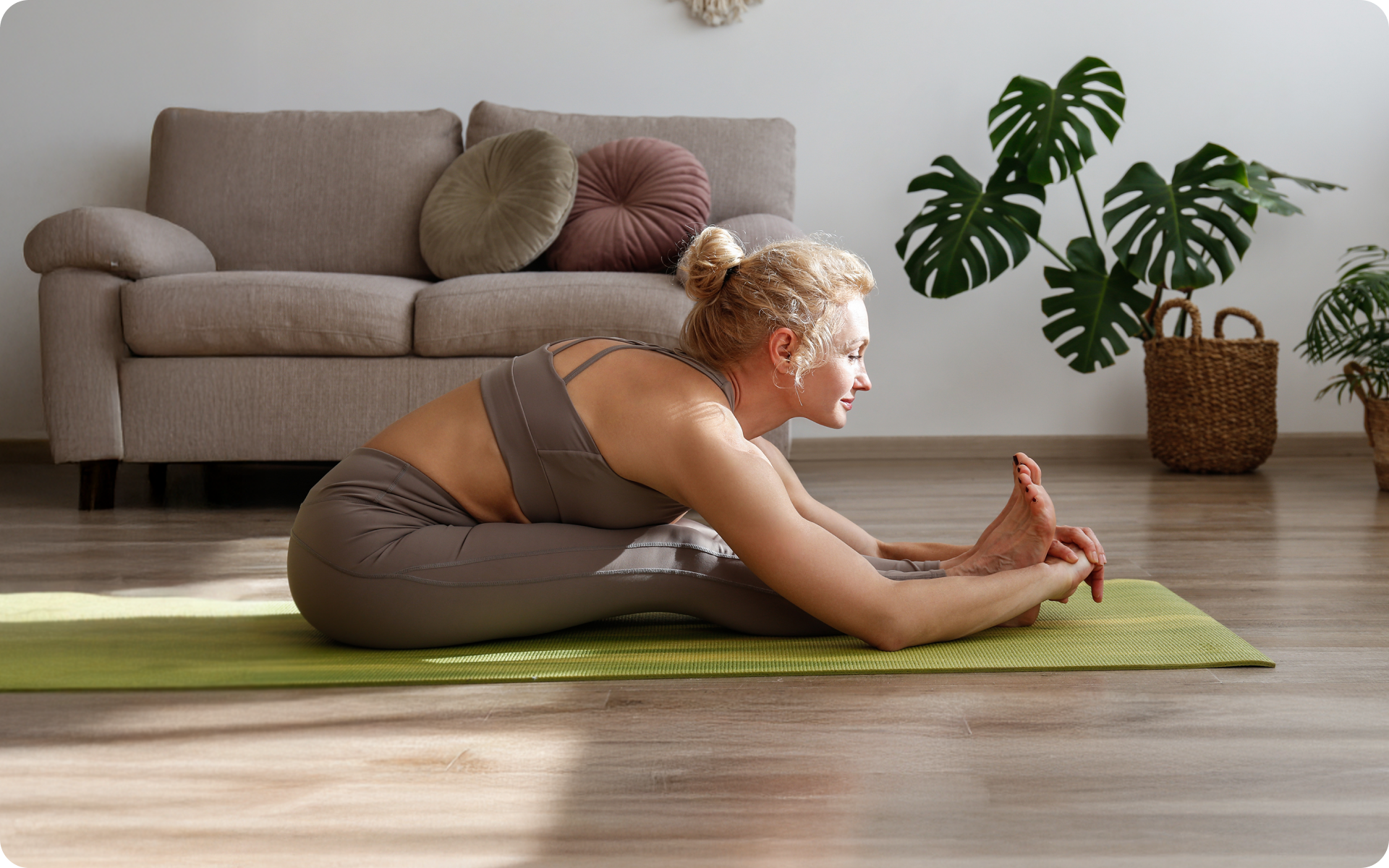If you live with knee or any other joint pain, then you know all too well how painful, debilitating, and restrictive life can be. Knee pain and weakness can be caused by multiple reasons ranging from muscle imbalances, knee injuries that cause ruptured ligaments or torn cartilage, as well as medical issues like arthritis, gout, and infections. One of the best ways to reduce this pain and strengthen knees is yoga. By doing yoga for knee strength, you can rehabilitate the weakened or injured muscles, which helps you get back not only your freedom to move around as much as you want, but the ability to live a much happier, pain-free life as well. If this is something that you’d like to try, then this article is for you. So, check out the following useful yoga poses for knee strength.
What Is Yoga Good For?
Before delving into the best knee-strengthening yoga poses, it is best to understand the benefits of yoga and why its advantages extend further than helping with knee pain and making this one joint stronger.
-
Helps Relieve Stress, Depression, And Anxiety
If you have been feeling extra stressed these days and are at a loss of what to do, try doing some yoga before or even at the end of your day. According to a study published in 2018 in the International Journal of Preventive Medicine journal, a group of women who did yoga 3 times a week for 4 weeks reported decreased levels of stress, anxiety, and depression (8).
It is also important to note that many yoga sessions also incorporate things like meditation, breathwork, chanting, etc. While these may sound like ‘new age’ nonsense to some, research has shown that these things can help reduce not only stress and anxiety, but can also boost your mood (2).
-
Helps With Flexibility
Many may often ignore it, but flexibility is an important factor in life, especially for people who work out. When you are flexible, you have more coordination and balance, and you have a much lower risk of injuries and muscle soreness. Two studies published in 2014 and 2016 showed that doing yoga anywhere between 6 and 10 weeks helps immensely with flexibility among athletes and other physically active people (9, 5).
-
Good For Your Mental Health
As seen above, this type of physical exercise has been shown to help manage depression, stress, and anxiety. However, this is not all it’s good for in terms of mental health. It has also been shown to help you sleep better, enhance your memory, improve your mood, and even promote recovery from and treatment of addiction (12, 4).
-
Can Reduce Inflammation
Chronic inflammation is the main culprit behind many illnesses that we deal with today. From diseases like arthritis, heart disease, diabetes, and cancer, everything can be traced back to chronic inflammation.
Luckily, you can use yoga to reduce your risk of chronic inflammation. According to a review published in 2018, researchers found that yoga had a significant impact in reducing inflammation across a multitude of chronic illnesses (6).
Read More: How To Do Sofa Yoga As A Beginner: Everything You Need To Know
-
Can Improve Your Strength
Did you know that yoga can actually help you improve on other forms of strength, aside from leg and knee bone strength? According to a study published in 2015, researchers found that using yoga as a strength training exercise not only helps reduce both body weight and BMI, but can also increase your grip strength, chest circumference, and much more (1).
-
Will Help Improve Your Body Image
Several studies have shown that the physical changes brought on by doing yoga consistently can help improve body image issues not only in adolescents and young adults but also in people with eating disorders like anorexia nervosa (10, 11).
Yoga For Knee Pain And Strength: The Best Poses To Try Today
Here are the best yoga poses to help strengthen your knee joint and relieve any pain that you may be currently experiencing:
-
Supported Chair Pose
Ordinarily, the chair pose is not done with any support, requiring you to essentially do a half squat in the air with your hands held straight above your head. However, if you have weak or painful knees, then this pose might make them hurt more leading to you falling over. The supported variation is much safer and easier not only for you but for your knees too.
- Choose a wall and go stand in front of it with your back towards it.
- Stand tall, about hip-width apart; then, slowly lean back till your back touches the wall.
- Slide down until your knees and ankles are parallel to each other. You should essentially be squatting against the wall.
- Lift your arms to the ceiling or simply place them on your thighs.
- Try holding this position for at least 30 seconds.
- Aim for a 2-minute hold.
-
Uttanasana (Aka Standing Forward Bend)
As previously stated, knee pain can be caused by multiple reasons. One of the most common reasons is having a too-tight IT band. The IT (iliotibial) band is a thick band of connective tissue that extends from your pelvic bone to the shin bone. This band works with other muscles in your thighs to provide maximum stability to the outside of the knee joint.
If this band becomes a little too tight, it can lead to pain and weakness in the knee. The Uttanasana is a great yoga pose to help stretch this muscle, which relieves any pain and weakness in this area.
- Begin by standing upright with your legs about hip-width apart.
- Hinge at the hips, dropping your upper body until about waist height.
- From here, fold your body all the way. Try touching your toes with your fingertips or even holding the toes.
- If you cannot do this, use the support of some yoga bricks or any blocks or boxes lying around the house.
- From here, cross your right ankle over your left and hold this position for about 30 seconds.
- Go back to the original position, cross your left ankle over the right and bend over again.
-
Setu Bandhasana (Aka Glute Bridge)
Also known as glute bridges in non-yoga fitness circles, this is a pose/exercise said to help strengthen the knee while also working your lower back, glutes, and hamstrings.
- On a soft surface on the floor, lie flat on your back and bend your knees.
- Make sure that your feet are shoulder-width apart and your hands are on the floor on either side of your body.
- Engage your core and glutes by pushing through heels to lift your body off the floor, so you’re resting on just your shoulders.
- Hold this position for a few breaths; then release your upper back, next is your mid back, and finally, lower your lower back and tailbone to the floor.
- This counts as 1 rep. Do 8 to 12 more reps for a proper stretch/workout.
-
Virabhadrasana III (Aka Warrior III)
This pose is said to help strengthen your ankles, legs, back muscles, and shoulders as well as improve your posture. In relation to the knees, warrior 3 strengthens the abductors on the outside of your hip, gluteus medius, and gluteus minimus, which in turn helps strengthen your knee.
- Start by standing with your feet together. Bring your hand together to the front of your chest as if in prayer.
- Find a point in front of you and stare at it.
- Begin to bend forward as you lift one leg behind you. Stop once your torso and leg are in a straight line. Make sure that your toes are pointed and that your leg isn’t sagging at the knee.
- Keep your core engaged and use the muscles of the standing leg to keep yourself from falling over.
- Hold this position for 30 seconds before getting back to the standing position and switching legs.
If you wish to cinch your waist, tone up your bat wings, blast away the muffin top – our fitness app was created to cater to all your needs! BetterMe won’t give excess weight a chance!
What Is Restorative Yoga Good For?
Unlike normal yoga, which is actively involving and smoothly moving through different poses with the aim of stretching your muscles and other connective tissues, restorative yoga is a more relaxed and passive form of this exercise.
According to Very Well Health and Healthline, restorative yoga is done at a slow pace and involves holding poses for a long time, staying still, and doing a lot of deep breathing. This form of yoga is said to push for physical, mental, and emotional relaxation.
Like other more active forms of yoga, restorative yoga has some incredible benefits for your body and mental health. Some of these benefits include improved sleep, increased relaxation, reduced stress levels, better mood, reduced chronic pain, and generally improved well-being (3, 7).
Restorative yoga is also said to be better for pregnant women and the elderly as it is more gentle on their fragile bodies.
The Bottom Line
Using yoga for knee pain is an easy and accessible way for anyone with a weak or painful knee to relieve the pain and/or strengthen this very important joint. With that being said, please speak to your doctor or physical therapist so you can make sure that you will not be overworking your knee when doing these activities, and thus hurting it further.
Get your personalized
meal plan!
DISCLAIMER:
This article is intended for general informational purposes only and does not serve to address individual circumstances. It is not a substitute for professional advice or help and should not be relied on for making any kind of decision-making. Any action taken as a direct or indirect result of the information in this article is entirely at your own risk and is your sole responsibility.
BetterMe, its content staff, and its medical advisors accept no responsibility for inaccuracies, errors, misstatements, inconsistencies, or omissions and specifically disclaim any liability, loss or risk, personal, professional or otherwise, which may be incurred as a consequence, directly or indirectly, of the use and/or application of any content.
You should always seek the advice of your physician or other qualified health provider with any questions you may have regarding a medical condition or your specific situation. Never disregard professional medical advice or delay seeking it because of BetterMe content. If you suspect or think you may have a medical emergency, call your doctor.
SOURCES:
- Age related differences of selected Hatha yoga practices on anthropometric characteristics, muscular strength and flexibility of healthy individuals (2015, ncbi.nlm.nih.gov)
- Effects of Singing Bowl Sound Meditation on Mood, Tension, and Well-being: An Observational Study (2017, ncbi.nlm.nih.gov)
- Establishing key components of yoga interventions for musculoskeletal conditions: a Delphi survey (2014, bmccomplementmedtherapies.biomedcentral.com)
- Exploring the therapeutic effects of yoga and its ability to increase quality of life (2011, ncbi.nlm.nih.gov)
- Impact of 10-weeks of yoga practice on flexibility and balance of college athletes (2016, ncbi.nlm.nih.gov)
- Impact of Yoga on Inflammatory Biomarkers: A Systematic Review (2018, pubmed.ncbi.nlm.nih.gov)
- The effect of yoga on sleep quality and insomnia in women with sleep problems: a systematic review and meta-analysis (2020, pubmed.ncbi.nlm.nih.gov)
- The Effect of Yoga on Stress, Anxiety, and Depression in Women (2018, ncbi.nlm.nih.gov)
- The effects of selected asanas in Iyengar yoga on flexibility: pilot study (2014, pubmed.ncbi.nlm.nih.gov)
- Yoga and body image: How do young adults practicing yoga describe its impact on their body image? (2018, pubmed.ncbi.nlm.nih.gov)
- Yoga as adjunctive therapy in the treatment of people with anorexia nervosa: a Delphi study (2021, pubmed.ncbi.nlm.nih.gov)
- Yoga for better mental health (2021, health.harvard.edu)










